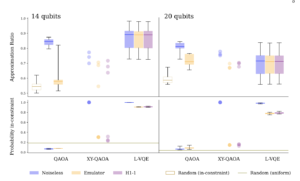
Trust me when I tell you that summarizing a large document — oh, let’s say, a scientific research paper — is a much more difficult task than you might imagine. Improving that ability to summarize long documents could help doctors offer better medical treatments, improve a legal teams’ ability to understand cases and, maybe, even replace lowly science writers in their quest to relay important findings of said scientific research papers.
Now, a team of researchers from JP Morgan Chase Bank and the University of Maryland report that quantum computers may help in this deceptively complex task.
In a study recently published on the pre-print server ArXiv, the team performed the largest ever constrained-optimization task on a quantum computer, specifically Quantinuum’s H1-1 device. In this case, the task was a type of text summarization with a goal to generate a shortened summary of a longer document without altering its original meaning.

instances on 14 (left) and 20 (right) qubits using different quantum optimization algorithms. (Image: ArXiv)
“This process is commonly used to produce summaries of news articles and voluminous legal documents,” the researchers write. “Specifically, we focus on a version of text summarization known as extractive summarization, wherein the summary is produced by selecting sentences verbatim from the original text.”

The researchers added that they mapped the executive summarization problem to an NP-hard constrained-optimization problem and imposed a constraint on the number of sentences in the summary.
The machine analyzed a dataset of 300,000 unique news articles written by journalists at CNN and the Daily Mail in English. To generate document summaries, the researchers relied on three quantum optimization algorithms — QAOA, L-VQE and XY-QAOA.
Critically, the results were achieved without error mitigation, which is just one technique quantum scientists use to manage the sensitive quantum operations that can be hampered by even the slightest environmental noise, such as heat or magnetic fields. Creating quantum devices that do not rely on error correction and mitigation techniques could lead to more practical use of quantum computers, most experts suggest.
The researchers chose the task because it’s both complex — and important.
“Extractive summarization — ES — is an interesting problem to evaluate the performance of quantum optimization algorithms due to its practical importance and complex structure,” the researchers write. “The goal of ES is to pick a subset of the sentences present in a large document to form a smaller document such that this subset preserves the information content in the original document, i.e., summarizes it. While many approaches to solving ES exist, in this work we focus on a particular formulation of ES as an optimization problem. Specifically, we consider the problem of maximizing the centrality and minimizing the redundancy of the sentences in the summary under the constraint that the total number of sentences in the summary is fixed.”
Fast Quantum Evolution
Besides providing a path to quantum advantage in yet another real-world task — and possibly forcing me to find a gig outside of science writing — the researchers suggest that the results show just how fast both quantum software and hardware has evolved.
“Our results demonstrate how algorithmic and hardware progress are bringing the prospect of quantum advantage in constrained optimization closer, which can be leveraged in many industries including finance,” the researchers write.
In particular, the scientists called out the performance of the H1-1.
“In our experiments on the 20-qubit Quantinuum H1-1 system, we observe that XY-QAOA with up to 20 qubits provides results that are significantly better than random guess despite the circuit depth exceeding 100 two-qubit gates,” the researchers write. “This is a testament to the progress in quantum computing hardware in general, and to the power of the Quantinuum H1-1 system in particular.”
They add, “Our successful execution of complex circuits for constrained optimization depends heavily on Quantinuum H1-1 system having all-to-all connectivity, as the circuit depth would increase significantly if the circuit had to be compiled to a nearest-neighbor architecture.”
The research team included: Pradeep Niroula, Ruslan Shaydulin, Romina Yalovetzky, Pierre Minssen, Dylan Herman, Shaohan Hu and Marco Pistoia.
The Department of Energy, the National Science Foundation, and the Defense Advance Research Projects Agency supported this work.
If you found this article to be informative, you can explore more current quantum news here, exclusives, interviews, and podcasts.

















